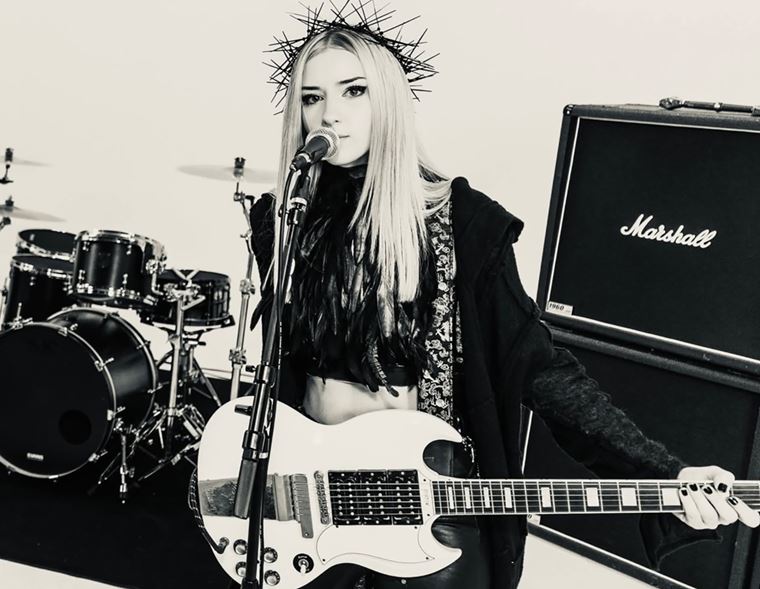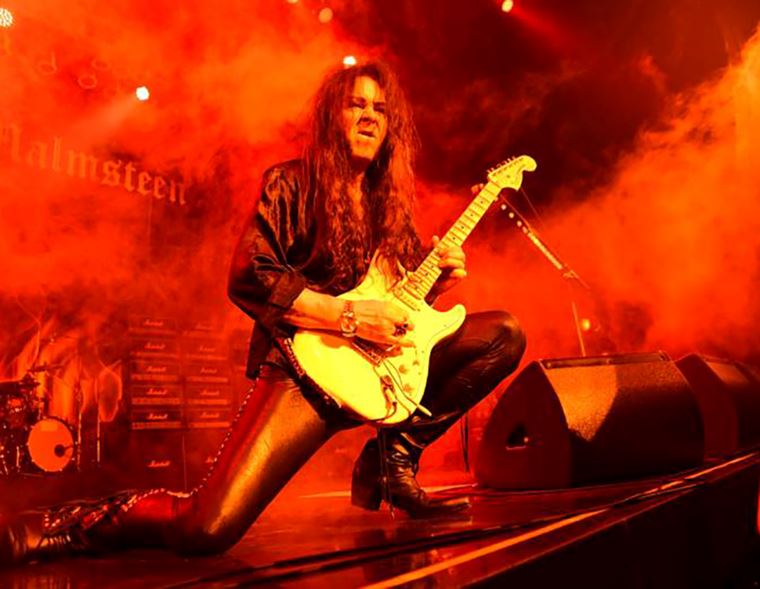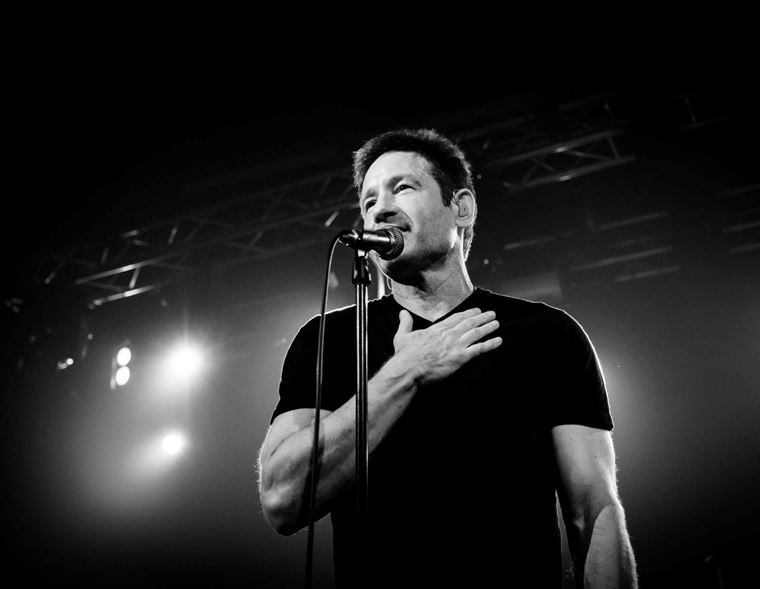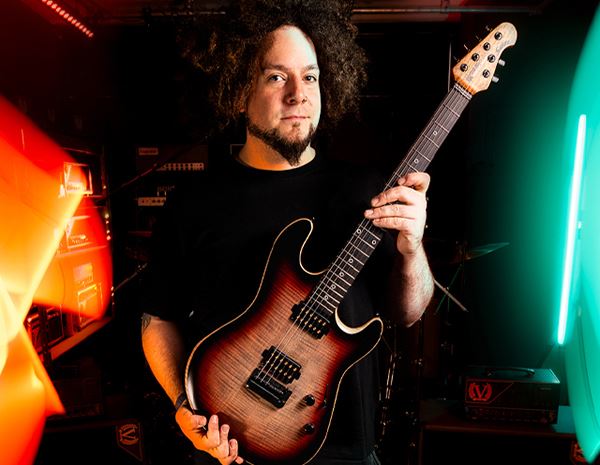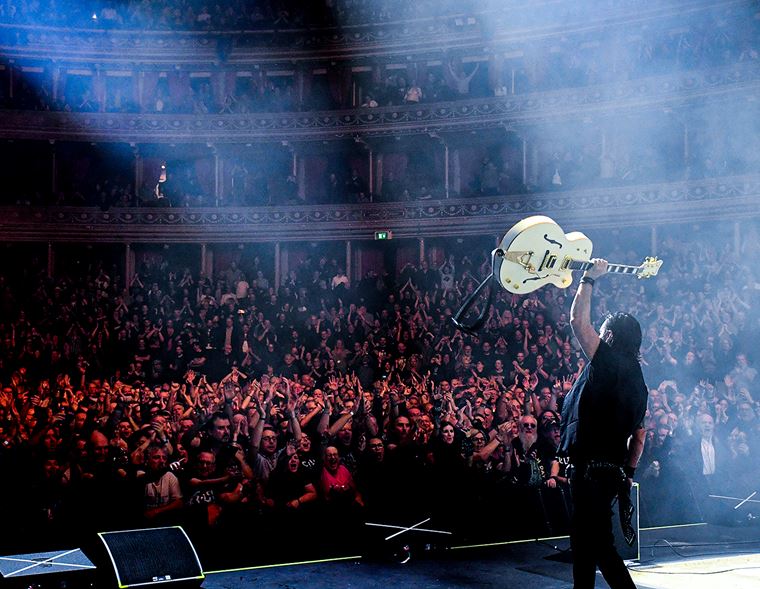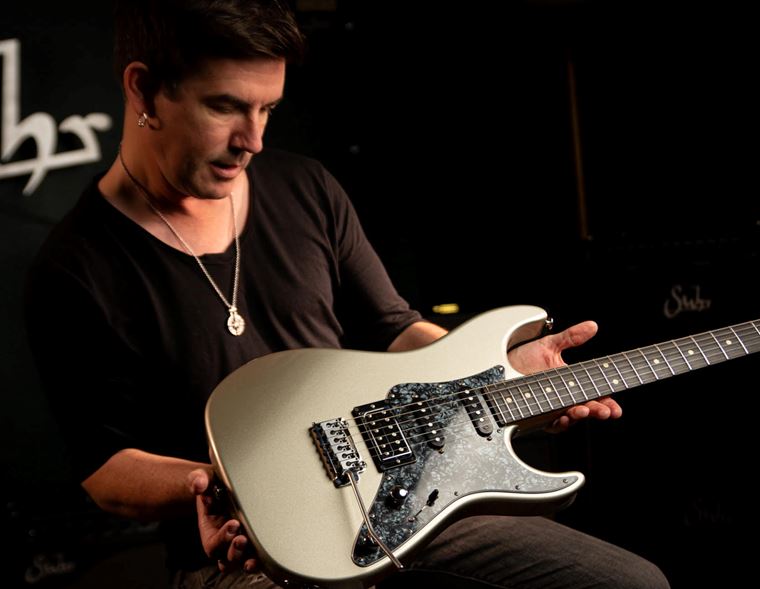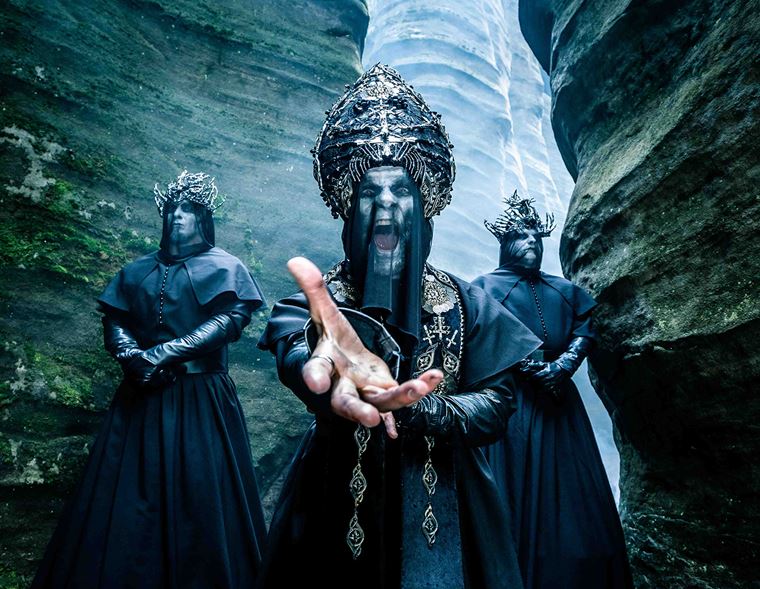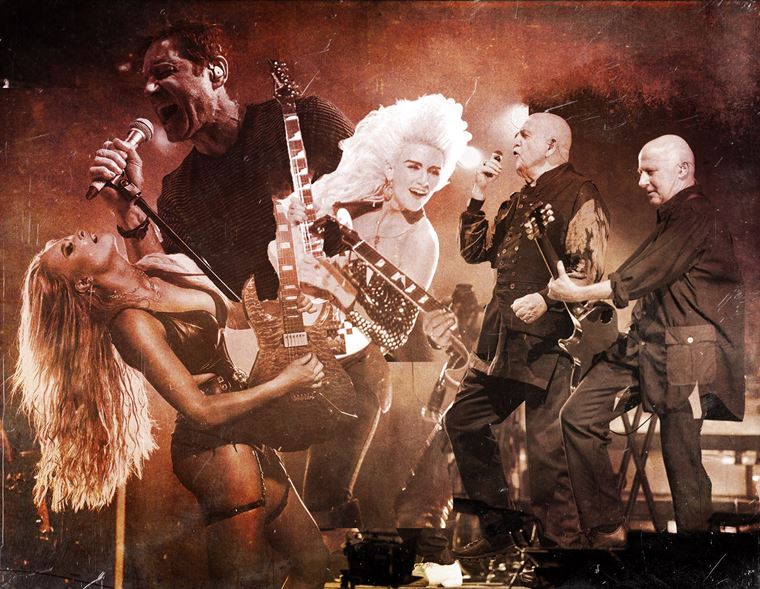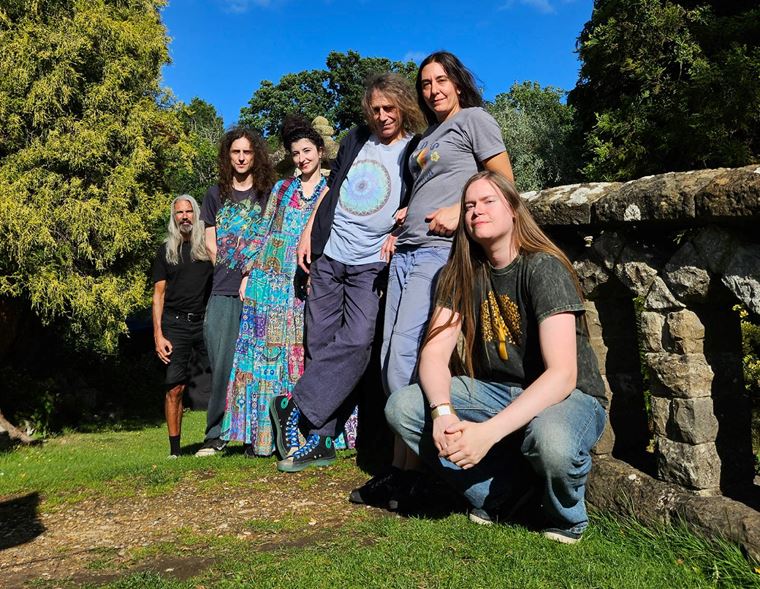REEVES GABRELS Epic Interview: Bowie, Eno, The Cure and More!
Published on 23 October 2020
Just imagine being the lead guitarist for The Cure.
You travel all over the world, play to enormous, passionate audiences and perform some of alternative rock’s most beloved music.
It must be pretty incredible!
Now, imagine being the lead guitarist of the Cure, when you’ve also already been David Bowie’s creative partner, co-writer and lead guitarist for 12 years?
How can that even happen?!
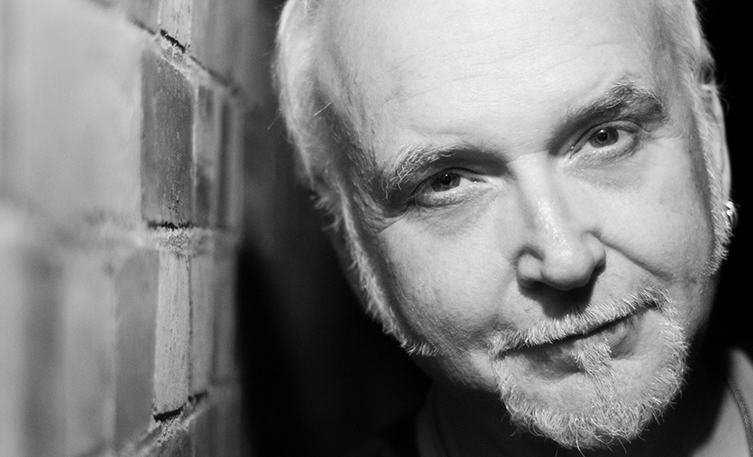
(Photo: Ken Lailey)
It sounds like a made-up story, but for Reeves Gabrels, these are the facts of his life. The extraordinary guitarist and songwriter has been at the creative nucleus of some of the world’s most popular music, and he’s still going strong. Reeves is well known for his wild, adventurous playing style that combines multiple opposing elements to create a new, fresh, individual style. He’s less well known for his role as co-writer of well over 50 songs with David Bowie, seven solo albums and co-production credits on many albums, including Bowie’s thrilling late 90s masterpiece, Earthling.
Not just an incredible guitarist, then.
Gabrels first showed up on the world’s cultural radar in the late 80s as a member of David Bowie’s Tin Machine band, before staying with him throughout his particularly adventurous and fertile 90s renaissance. Gabrels’ pioneering use of technology within a lead guitar context did much to further the development of what was possible on the instrument in a modern artistic context. His creative attitude was about looking forwards, breaking new ground and understanding that the guitar is about ideas as much as it is about technique.
It’s sometimes difficult to know where to begin with Reeves, in terms of introducing him to you. As a full-time member of The Cure, Reeves co-writes and performs with a band that defy categorisation as they continue into four decades as one of the biggest acts Britain – and the world- has even known. That would be reason enough to look forward to a conversation with him, but we also wanted to know about his time with Bowie, his signature Reverend guitars and his solo records...
How would we ever fit all of this in?
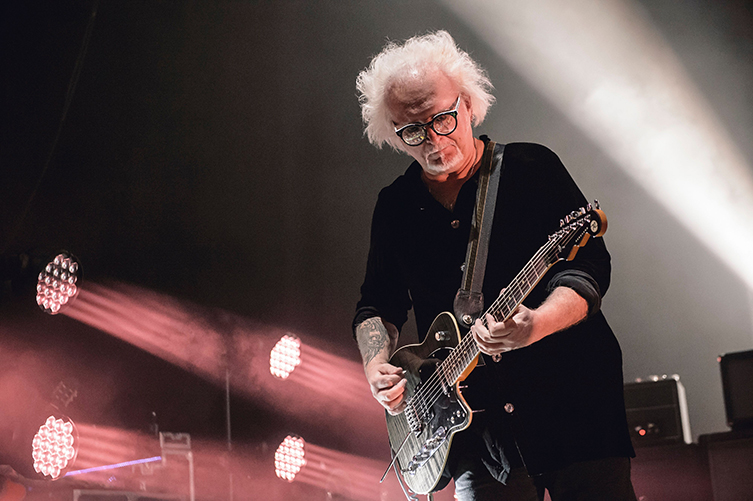
(Photo: Mauro Melis)
It’s difficult to believe that Bowie’s Outside album is 25 years old. The grandiose, ambitious, cinematic and -by turns – creepy & nightmarish album did much to restore Bowie’s reputation as a maker of statements and concepts. The sci-fi serial killer story brought Bowie’s love of character and theatre to life, and the record still sounds as fresh and bold today as when it was released in 1995. Fans of the movie Se7en will appreciate a lot of the album’s mood and texture and indeed hear the sinister single Hearts Filthy Lesson playing over the film’s end credits. (See the video a little ways below when we return to this song)
This 25th anniversary, then, was the occasion on which I decided to contact Reeves. Such an album, released in the middle of the Britpop era, deserves to be reappraised and celebrated for its achievements. It was like a Rock album version of Twin Peaks, and every bit as elliptical and artistic as that pioneering TV show. I wanted to know how Reeves felt about his work, back then and now. I wanted to know about all of those other subjects too, but you have to find a starting point, right? I reached out, made my pitch and was delighted to receive an affirmative response. We were on!
Facetime provided the platform this time around, and I found Reeves to be a fantastic person to talk to. He’s very smart and quick, laughing a lot, great with details and always ready with an excellent anecdote. In the end, we spoke for well over two hours, and I just couldn’t fit everything in! We covered a ton of ground, from Reeves’ days at Berklee, through the amazing adventures with Bowie, to his current time with Robert Smith and The Cure. A colourful cast of supporting characters added colour to our conversation, including world-famous artist Julian Schnabel, producer Brian Eno and Oscar-winning actor Gary Oldman.
I told you: you’d say we’re making it up!
Here, then, is our far-reaching conversation. You’ll find loads to love here, I hope, whether you are a Cure fan, a Bowie fan or just into guitars! There’s news on new Cure material, stories about going AWOL with Robert Smith and of talking art with David Bowie. It’s some story, all right, so let’s get to it...
David Bowie / Outside
guitarguitar: Reeves, there’s loads that I want to ask you: so much so that I’ve divided my question sheet into 4 sections: Bowie, The Cure, Reverend guitars and Solo work. Does that sound OK to you?
RG: Yeah, that’s fine!
GG: Cool, so, 25 years of the Outside album! You’re known of course as David Bowie’s guitarist, but you were much more than a guitar player. You were the co-writer of many tracks and in fact his creative partner in many ways. Is that the correct way to put it?
RG: Yeah, you know, my mother bought me Ziggy Stardust, you know? There was no way in hell I was ever gonna end up working with David, or someone like him. It was a shock! When we met and began to know each other, I didn’t tell him I played guitar till he found out and asked me! When it started to happen, he was at a point in his life where he wanted to write with someone. Prior to 1989, he really didn’t co-write that much. He’d written one or two songs with Carlos (Alomar, guitarist) and some stuff with (Brian) Eno, but he wasn’t that welcoming, I guess, or did want or need, or maybe just didn’t give out credit. That’s kinda the story with Mick Ronson: according to Visconti (Tony Visconti, Bowie producer and collaborator on many albums), The Man Who Sold the World album should’ve been a Bowie/Ronson co-write.
GG: Oh, ok!
RG: But I don’t know, and I didn’t hear that until much later in my time with David. Anyway, I just did what I’d done in other bands I’d been in. I wanted to play guitar but there were other things that needed to be addressed, like, y’know, songwriting or arrangements or whatever. So, I just went into the vacuum. Nature abhors a vacuum! (laughs) And the other thing was, my real reason to start being involved in writing more was that I wanted to set up the guitar playing better!
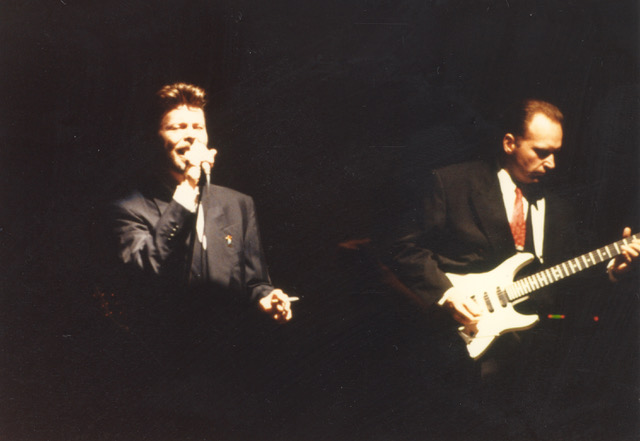
(Photo: Sara Terry)
But, you know, I love arrangements and to this day, I love taking a song and doing a complete rearrangement of it. From going to music school and having an 11-piece horn band at one point, taking various writing classes and stuff...that’s what actually drew me to Berklee (College of Music in Boston – Ray). I was going to the School of Visual Arts and Lou Stallman from the Brill Building - which was where Carole king and all of those people came from - he was teaching an elective. I needed to take what was considered an English class. Songwriting-101 was considered an English Class, so I took that! One day, he said, ‘Are you playing guitar on that stuff? (Recorded homework) I said yeah, and he said, ‘You wanna cut your classes this afternoon and do a session? Make some money?’ So, he started hiring me! That’s what brought me up to Berklee. So, the songwriting thing was part and parcel of it, but never my primary focus. Now, 30 years later, I’ve got close to 60 co-writes with David, and I don’t know how many co-productions. I don’t know how I got here, I just wanna play guitar! (laughs)
"I had this one thing that I had written at a soundcheck where I was trying to combine Philip Glass and Merle Travis"
GG: Totally! Haha! That’s interesting, what you said about your Visual Arts background, because one of the things that really interests me about the Outside record is the vein of art that runs through it: there’s the concept, with the Art Crimes story, and David was painting a lot at that point. I’d love to know if the concept was there from the beginning of your writing sessions, but also: you and David made friends first of all by talking about art, didn’t you?
RG: Yeah, and he thought I was a Fine Arts painter that just was, y’know, into music as well. We were exchanging art books and regular books. He turned me onto ‘Shock of the New’, which is kind of definitive. I’ve turned other people onto that a lot because the ‘shock of the new’ is always coming up. Two years from now (laughing), there could be another shock! But yeah, it was much more of a friendship before it was a working relationship, and even the working relationship was never really professional, haha! It was pretty funny, most of the time. It was a good laugh.
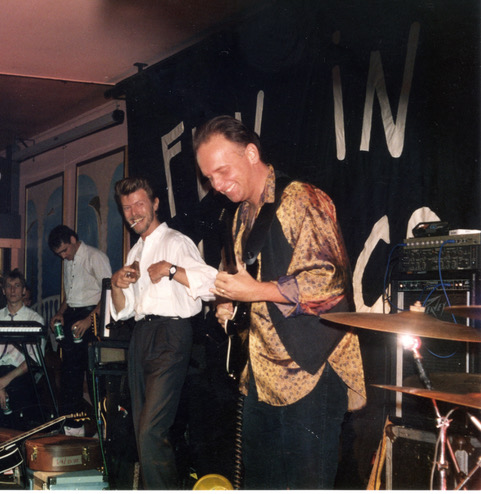
(Photo of a surprise pub gig in Sydney, 1989, during the making of Tin Machine II. Pic courtesy of Reeves Gabrels)
After touring with Paul Rodgers, I flew over to work with David. At that point, Brian wasn’t there yet, so it was just David. It was at Mountain Studios in Switzerland, and I would always fly over with some song ideas. I had this one thing that I had written at a soundcheck where I was trying to combine Philip Glass and Merle Travis (grins) and that was what became Voyeur of Utter Destruction.
GG: Of course, I know that part you mean!
RG: That fingerpicking pattern: that was in the days before good looping or Pro Tools - in 1993, nobody really had that, or at we didn’t – so I had to play it. I was playing the Parker Fly at that point, so I had the acoustic pickup out and the electric pickup. I was running everything in stereo. I basically tracked four different guitar tones at the same time, and I had to play that fingerpicking pattern until the very end, when the guitar solo starts!
My clearest memory of it is playing it on stage. Four minutes of this 16th-note fingerpicking pattern, and then I had eight bars where I didn’t play anything and then the solo would start. So, for those 8 bars, I would just stand on stage, shaking my arm out!
So, I had a couple of songs going in, and then Brian showed up and the rest of the band showed up. We did do a battle at the end because a bunch of the songs were written in jams. We created a whole song form, and David sang over it in real-time. All of those pieces that have six writing credits in them? Those are the ones that were improvised, completely improvised, including David’s vocal in real-time. We cleaned it a little after with backing vocals or whatever.
"I believe the characters revealed themselves on the two jam days. At that point in time, the whole William Gibson thing was happening, and that was an influence, and Neal Stephenson’s Snow Crash."
GG: Was that your first professional project with Brian Eno, then?
RG: It was my first and last! And I had a great time with him. We went out and had dinner probably 5 nights a week whenever he was there. The last two days, the band’s ESP was pretty tight by then, so we did a three hour jam each day. That got edited down. By early ’95, they’d taken that edited-down opera - which is what Outside was - and taken it to record companies. We had managed to get David out of his record deal with Tin Machine (laughs), so he didn’t have a record deal at that point. They’d heard the record and said, ‘well, there’s no single here!’, which there wasn’t, and that was the idea! David was used to getting a $4 million advance and they were only giving $2 million, so he decided - taking advice from the money guys, unfortunately – that we needed to record some singles.
GG: Right.
RG: So that’s when we recorded in New York. We did Strangers When We Meet. That’s when those other players came in: Joey Baron and Carlos, for those three songs. Carlos is an amazing player, and he’s got his own thing. People act like rhythm guitar is less of an art, or it’s not a big deal, but you just have to stand next to Carlos to realise what you don’t know.
GG: Yeah, yeah, totally. With the Outside record, then, was the concept something that you and David had fixed? Could you write ‘to’ it, as it were, with the narrative and the characters?
RG: I believe that we had...what was going on in David’s mind, some of it I was privy to, and other times it wasn’t what I thought it was, but in this case, I believe the characters revealed themselves on the two jam days. He had this thing called the Verbasizer, where you put a paragraph in from the Evening Times, and a whole different thing would come out. In one of the songs there’s a phrase, ‘it’ll end in chrome’ (the song is ‘Segue – Romana A. Stone/ I Am With Name’ - Ray) and I thought, ‘that’s a great line!’, if you wanna get into the whole cyberpunk thing. At that point in time, the whole William Gibson thing was happening, and that was an influence, and Neal Stephenson’s Snow Crash.
So, there was that thing going on, but the characters like Baby Grace, Nathan Adler and Ramona, that all came out that day in characters. I imagine it was probably gestating. I know that Brian and David went to the asylum and met some of the inmates. The Viennese artist Hermann Nitsch was a big influence on Outside, too.
GG: In terms of the sound of Outside, then, it’s 25 years old but it still sounds futuristic. You were mentioning before about recording four simultaneous tracks of guitar. There are some really stand-out guitar moments, like for example the main riff on Hearts Filthy Lesson. That, to me, sounds like a sampled part. It’s not, though, right?
RG: No, I actually played it more than you hear. (laughs) I kept playing it throughout the song. That’s again the Parker Fly, and I had the electric guitar going through this Univox Unitron, which is a cheap version of the Mu-Tron that they made in the 70s. And I got it when it was new! It was just horrific, uncontrollable, but you could dial it in and get it to do some things. So, I had that on one side, and I had the acoustic sound from the piezo bridge on the Parker on another track. When we mixed it, we laid that over the top so that is had a lot of definition. I played with a bottleneck.
So that’s where that sound came from, but what we had to do was actually mute what I played, because I probably played the line every 8 bars or every 4 bars. That happened in real-time.
I know that Brian and David went to the asylum and met some of the inmates.
GG: Wow! My mind’s blown about a bottleneck being involved! So much of your playing is daring and futuristic but there’s still that flattened 5th of the Blues in there.
RG: Right before we started that record, I did an album with my friend Dave Tronzo, who is a slide player. He and I, to this day, are not sure who plays what! Maybe because of me with the vibrato bar and him with the slide, we kind of stole licks from each other.
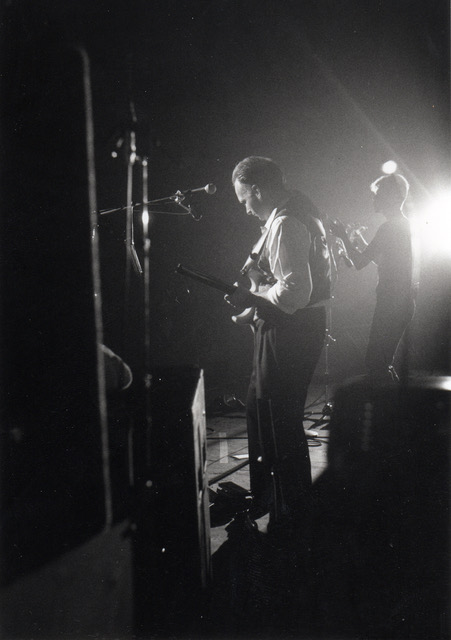
(Photo: Sara Terry)
GG: So, before we move on from the Outside stuff, I wondered about two things: one thing was, I’ve never spoken to a musician who has actually used Eno’s famous Oblique Strategy cards, and I wondered whether those were present during the session?
RG: They were there. They were in the room! (laughs) I don’t recall us using them at all. There were a couple of things we did where Brian wrote a scenario.
GG: Right.
RG: But he only did that two or three times. The press part of it has made it sound like that’s how we did the whole record, but it was actually just two or three things where, like, we were the house band at a worker’s bar on, y’know, one of the moons of Jupiter.
GG: Of course!
"A good band is like a good conversation. A genius band is like a surreal version of a good conversation."
RG: Like that kind of thing. One of the other things was, he and David would put up something like ‘Dancing in the Streets’ by Martha and the Vandellas in our headphones, and our instruction was, ‘play along with it, but don’t play any of the lines that exist in the song’. And then after we did it, they’d remove that, and you’d have something that had sort of an off-kilter form.
GG: That’s pretty Eno-esque, I guess! And finally, for Outside: it was an ambitious concept, and I know it got reduced from a huge number of possible songs in order to fit a single disc, but 25 years later, how do you feel about how it turned out?
RG: Well, I was disappointed with the mix, with the sound of it. I felt like it was more polished and lighter in the bottom end than I wanted. It was a little awkward because David and I had done so much with Tin Machine and we were friends: when I would go there, I would stay at his house and ride to the studio with him, so it wasn’t like I was just a hired guy.
GG: Yeah.
RG: One of the things about Brian is, the idea is his instrument. He’s not, y’know, he’s a four-fingered keyboard player at best and he’s in a room full of people with chops. He also made the mistake of saying in front of Erdal (Kizilçay, bass and keys) and Garson (Mike Garson, piano), I knew what he meant, but it was like ‘You know, musicians really don’t belong in the recording studio’. (laughs) That afternoon, he was trying to conduct one of the jams and they all kind of looked...I knew what was up so I went with my fellow musicians...he was trying to get us to go to a change so we just held it back for, like, four more bars on purpose. We hazed him a little bit.
And also, the song Hallo Spaceboy. I had written a thing in the Summer with David called Moondust Will Cover You. It was a slow thing: same chord changes but half the tempo of Spaceboy, and David had sung ‘moondust will cover you’, but it didn’t have the Spaceboy part of the lyric. He and Brian were in New York before I came, and Brian doubled the tempo and added a drum machine. I thought, ‘Cool, that’s great!’, but somehow my writing credits fell off. I didn’t find out I didn’t have writing credit until the album came out.
GG: I didn’t realise there were so much politics involved with that particular album, that’s really unfortunate.
RG: Yeah. It’s like what they say about Law and Sausage: you don’t want to see either one made. (laughs) It gets weirder when the stakes get higher, and the reason the stakes get higher is that the money goes up. But it was an adventure! And a lesson!
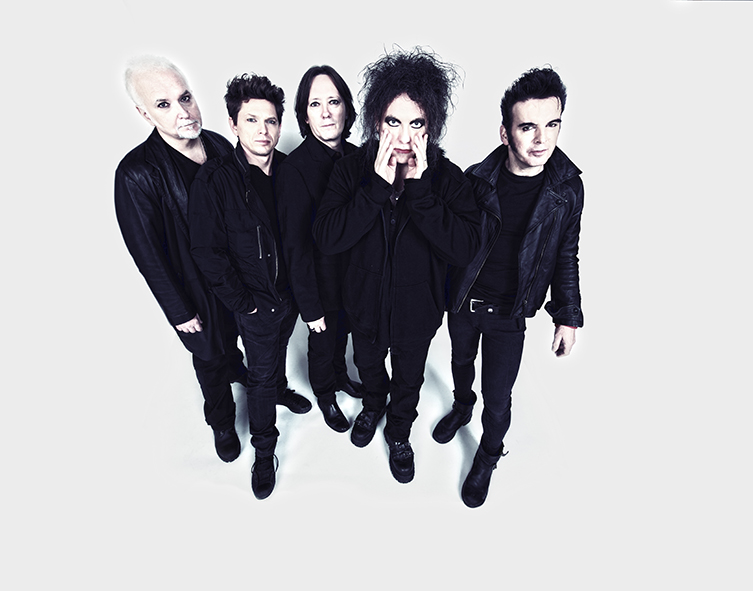
(Photo: Andy Vella)
Gigging with The Cure
GG: So, the other ‘relatively high-profile’ gig you have is with The Cure. That’s about as big as gigs get! That’s 8 years you’ve been a member of The Cure, is that right?
RG: Started 2012, yeah.
GG: So, did you know Robert Smith prior to that? Did you meet him through David?
RG: David invited him to play at his Birthday show (Bowie’s 50th at Madison Square Gardens - Ray). I was the musical director for that, so I had to make sure everybody knew the songs. Robert and I first started communicating via fax, going through the two songs he was going to do: The Last Thing You Should Do, from Earthling, hadn’t come out at that point, and Quicksand. And, you know, Robert does his homework. He probably knew Quicksand, in terms of what was the right chord inversion and where it’s played on the neck (laughs), whereas I’m like, ‘Well, that’s an ‘A’, that’s good enough for me’.
GG: Sure.
RG: He had it all figured out. Then, when we got to rehearsals, we got together to run through his songs, and it was pretty obvious that two hours before dress rehearsals was all he needed. That was a Wednesday night. The dress rehearsal was the Saturday and Sunday, and the show was on the Monday. The last thing I remember was us going out on Wednesday night, and the next thing I remember was he and I sitting in the lobby of the hotel on Friday morning. We looked at each other and said, ‘You know, we should probably get some sleep!’ (laughs)
GG: Nice! I like that.
RG: He was the last one in. After him, my responsibility kinda ended when we went through those songs. Everything else was in place and the production manager was taking care of setting everything up. We rented a small arena in Hartford, Connecticut to rehearse before we got to Madison Square Gardens. So, until we got there on Saturday morning, there was really nothing to do. I’m not really sure what we did for that day and a half! I apparently had a good time!
GG: Yes! Well, it lasted!
"I said to Robert, 'You know, I don't really have that much modulation stuff, especially Chorus. The next day, he brought in a crate of Chorus pedals."
RG: Yeah! So, after we did the birthday show, the aftershow - Julian Schnabel let David use his workspace – so we were there for the party. There was a security guy at the door. We’re there and I don’t know whose idea it was, but Perry Bamonte, who was the guitar player for The Cure that the time, he was there, and me and Robert. Someone said, ‘Oh, look, Julian’s paintings are up on the wall! They’re just here, like museum-level art.’ And I said, ‘You know, I bet if we took one down and walked out the front door and told the security guy that they gave it to us...it’d be okay! We got almost to the guy at the door and he looked at us and pointed to the space on the wall! (laughs) And we put it back up. I’m surprised that he was that cool about it.
After that, on the last day of the 1997 tour, I got a phone call from Robert. ‘Look, I know you’re in Budapest and you have to fly back to the States, why don’t you stop back in England, I’ve got this song I want you to play on.’
GG: Oh, cool!
RG: I detoured, slept on the plane, and the song was Wrong Number.
GG: Oh yeah, yeah!
RG: That was the first time I worked with Robert. Then, about a year later, I booked 12 hours in Westside studios in London and invited Robert. I said, ‘Let’s just go in, write something and record it’. That’s what we did and that became the song called Yesterday’s Gone from my second solo record. After that, we did a thing for the South Park guys on a movie called Orgazmo. Robert, Jason Cooper (The Cure’s drummer) and I wrote a song together called A Sign From God, under the name COGASM, which was a name Robert made up from the first two letters of each of our surnames!
I stayed in touch with Robert, and in 2012 I was gonna be in London. He wrote back, saying ‘Wait, when are you coming over? What are you doing the whole Summer?’ That just turned into ‘Can you learn 30 songs in three weeks?’ (laughs)
So, about a week goes by and he sends me ten songs. Another week goes by, I call him and he goes, ‘Oh, you know those ten songs I sent you? Forget those, we’re not gonna do those. I’ll send you the whole set tomorrow’. Then he sends me 55 songs and I’ve got 8 days till rehearsal in Brighton where we had another 5 days in rehearsal before the first show.
GG: Wow!
RG: They’re not... I’m stating the obvious, but they don’t follow blues form (laughs). They don’t follow anything that you can necessarily anticipate. Very often, they don’t even go to the dominant chord or return to the ‘1’ chord: sometimes they’re just two chords! I was a fan of the Cure but the first record I bought was Head on the Door, so I was late to the party in terms of the 80s. The Cure’s music was omnipresent, in a way, and it was also the reason why I did not use a Chorus pedal! (laughs) That was the sound of The Cure!
"When you have fewer people, you can take more chances. Festivals are great, but you have to paint with broader strokes."
GG: Very much!
RG: When I got there, I did buy a BOSS Dimension, the purple one, which I still have on my pedalboard. I said to Robert, ‘You know, I don’t really have that much modulation stuff, especially Chorus. The next day, he brought in a crate of Chorus pedals! (laughs) I was building my pedalboard as we were learning the songs, every time we came up against something I couldn’t do.
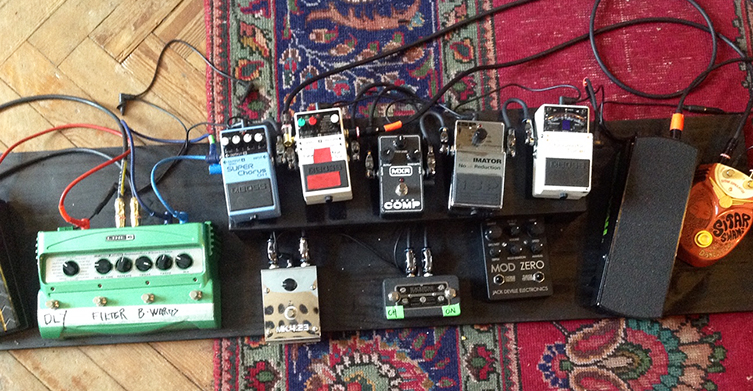
(Reeves' pedal set up for his initial Cure gigs in 2012...)
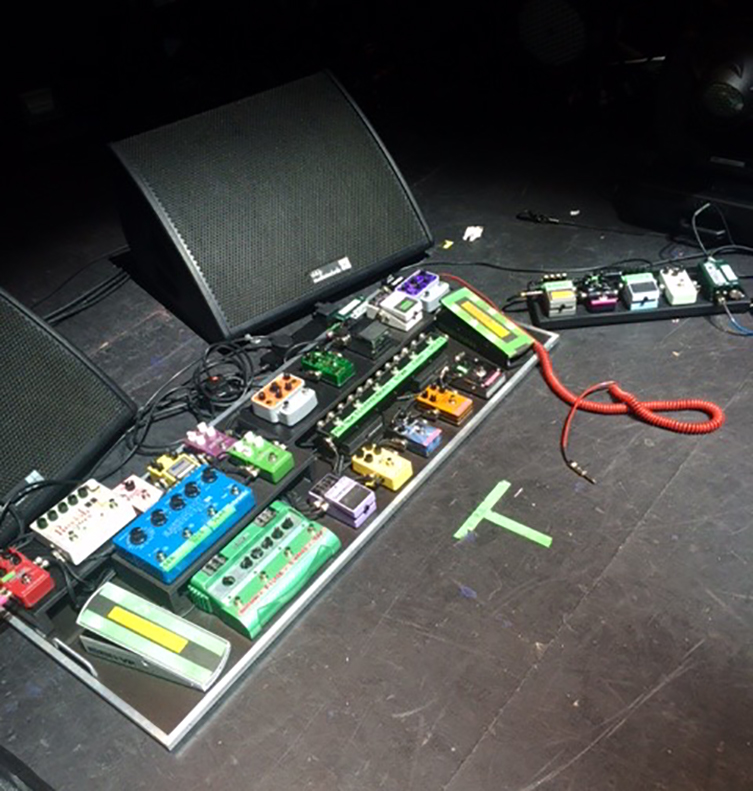
(...and his pedal board for The Cure circa 2016! Pics courtesy of Reeves Gabrels)
And the other thing: they were really tight when we rehearsed! From the first song, I thought, ‘Oh, fuck!’ You know? (laughs) It wasn’t until about two years later I found out that they’d gotten together for a week before I got there.
GG: Yeah, just to show you!
RG: Yeah!
GG: So, in terms of your job within The Cure, there’s a huge body of work there.
When you have fewer people, you can take more chances. Festivals are great but you have to paint with broader strokes. You have to lay off the 32rd notes!
RG: Yeah.
GG: And Cure gigs have a reputation for being between two and three hours long, quite a lot...
RG: That’s on a quick night!
GG: Hahaha! So, I mean, there’s so much for you to learn! How do you even...I mean (Reeves starts laughing) where do you even begin?
RG: (Reeves rummages around off camera and brings out a folder bursting at the seams) There’s this! Look, Plainsong, right there on the top.
GG: That’s my favourite Cure song!
RG: A good chunk of the first Summer, I made myself an 11x14” book with the set in it. We ended up with about 50 active songs and we played maybe 37 a night, depending on whether we had plenty of time or whether it was a tight two-hour festival thing. But they’re all finite lengths: there’s nothing that we really stretch. Springsteen will play for three hours, but there’s a lot of vamping going on, there’s a lot of audience participation. We’re playing songs. So, by 2017, we have 127-128 songs active.
GG: Goodness me.
RG: And the same last year. Some things change, some things fall off, and there’s probably twenty songs we have to play every night, at a festival anyway, because people go away unhappy otherwise. When we did Meltdown and then Hyde Park (two huge London shows close to each other – Ray), they were largely different sets. The Royal Albert Hall only hold like 2500 people, I think, so when you have fewer people, you can take more chances. I liked it, it felt sweatier and darker (laughs). Festivals are great but you have to paint with broader strokes. You have to lay off the 32rd notes!
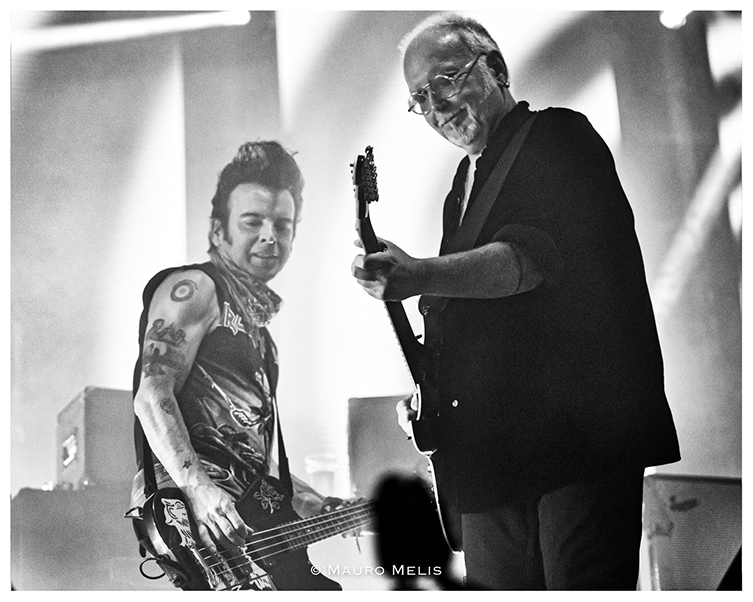
(Photo: Mauro Melis)
GG: Haha, definitely. Talking of painting with broader strokes, in terms of tap-dancing with your effects, are you going for maybe 4 or 5 sounds that are ‘Cure-like’ enough to get you through the set? Is that how you approach that?
RG: At the beginning, it was kinda ‘survival’. Pictures of my 2012 pedalboard and my 2019 pedalboard will tell the tale! The thing of it is, is that Robert sounds exactly like Robert and it sounds like the band, and he has two BOSS BCB-60’s, you know? With just 5 or 6 BOSS pedals in each. That’s how he does it. The reason he has so many, is that he has duplicate pedals set for different delay times. I’m in awe of that.
My job is a little bit different. Because he’s the singer and the guitar player, and I’m the guitar player, I have to pick up some of the weight. That was the whole idea: that I do more of the heavy lifting! The other side of it is, when it comes to solos or featured guitar parts, I mean, I’m doing a fair amount of Bass VI stuff, and stuff that’s hard for Robert to play and sing, but when it comes to solos on certain songs, I keep thinking of seeing Neil Young with Crazy Horse, but with Nils Lofgren playing with him. Nils is a more technically proficient player, let’s say...
GG: Uh-huh, sure...
RG: He’s got more speed and whatever, though no one cares about that kinda stuff, but if you’re playing Southern Man or Down By the River, or Cortez the Killer, there’s no point in Nils Lofgren taking a solo and trying to sound like the way Neil played it when Neil is right there! It’s authentic and it’s real.
"There is some debate about how close to release it is, but it’s definitely on the dark and heavy side. It’s like Friday, I’m in Hell, you know?"
GG: Totally.
RG: Neil doesn’t have to think about being Neil: he is Neil, you know? (laughs) And Robert doesn’t have to think about being Robert, he is Robert. What Robert has made me think about more is: you are you. So you be you! Because some of my life has been just having to...I’m not so much a parts player as an improviser, but when I’m playing songs, I wanna serve the song and sometimes that means I go too far (laughs) I was doing a session in Nashville in 2010 or 11, and I was trying to play all these responsible things that I thought the song needed. The producer said, ‘Reeves, I can walk out the front door and spit and hit a guitar player who can play the parts you think the song needs, but I can’t walk out an spit on someone that’s gonna do what you do. So, that’s why you’re here, will you just do that?’
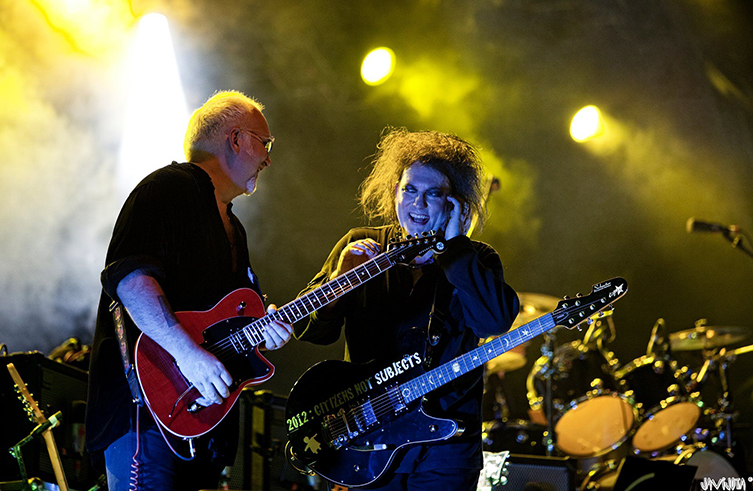
(Photo: Javier Juarez)
GG: Haha, that’s a great thing to hear!
RG: And that’s easy!
GG: Yeah, being yourself.
RG: Well, yeah: it’s my cross to bear! (laughs)
GG: Totally, now you may or may not have an answer to this next one. Before we move on to the Reverend stuff, I do know that there was some chat last year, before all this nonsense with Covid, that there was maybe going to be some new Cure material on the horizon? I don’t know if you’re able to comment on that?
"Looking at it from a US perspective, The Cure is the quintessential British band."
RG: Oh yeah! We have several albums’ worth! Before we went to South Africa in March last year, we were in the studio from January. We’ve been back and forth on it. 2019 was a busy year, and then we ended up doing the festivals, and Glastonbury, and then just tried to finish up some of the recordings and stuff. There is some debate about how close to release it is, but it’s definitely on the dark and heavy side.
GG: Oh, that sounds amazing!
RG: It’s like Friday, I’m in Hell, you know? (laughs)
GG: Hahaha, oh, that’s great! Well, I won’t push you for any more details on that just yet, but that’s amazing news!
Reverend Guitars
GG: So, Reverend, then. That’s ten years you’ve been with Reverend now, and of course, somebody like yourself can play any guitar he wants, so what drew you to that brand in particular?
RG: Well I had a couple of years – 2005 till 2007 – where I had gotten Lyme disease. I couldn’t stand up and play for two hours for about a year. I was legally blind, and lost my balance, stuff like that for about three months. And so, I didn’t go to any of the NAMM shows! (laughs) I recovered and everything’s fine, but I wasn’t really looking at new gear. I went to NAMM show in Nashville, where I was living at that point, and a friend of mine, Audley Freed (session ace, Black Crowes guitarist – Ray) introduced me to Joe Naylor and Ken Haas. I checked out their guitars, and it was a Double Agent – it had a P90 in the neck and a humbucker in the bridge – they gave me to try. At that show, Peavey Custom Shop, Fender and a couple of other people had all sent me guitars and they all came on roughly the same day.
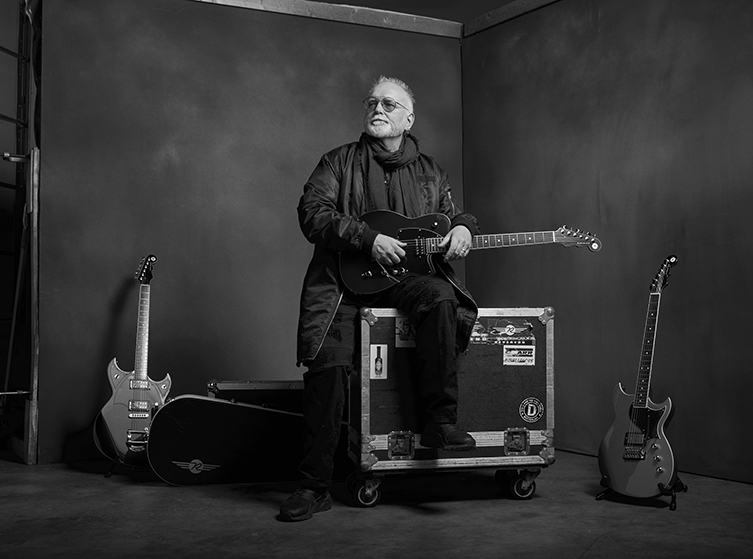
So suddenly, I’m at home and I’ve got 4 new guitars to choose from. At that point in time, I had a gig on lower Broadway, in Nashville. That was part of my recovery! There’s no rehearsal: the song gets called and, y’know, you just chance it, you just go. So, I was trying the guitars out at that, and I kept bringing the Reverend. I was bringing the Reverend everywhere. Finally, I called up Joe and I said, ‘Joe, I really like this guitar!’ We just started talking and I ended up with a signature model. (laughs)
So, we did that one (the Reverend Reeves Gabrels Signature) and then we modified it. As I often do, I go through periods where I don’t want to use a tremolo. I start to feel like a cartoon of myself. I get asked often to do stuff with the tremolo and sometimes it feels like a cliché of me: that thing with the whammy bar and the Sustainer. If I live in that space too much, I feel like a caricature.
GG: Mm-hmm.
RG: If I leave it alone and come back to it, it feels fresh again.
GG: I can understand that completely.
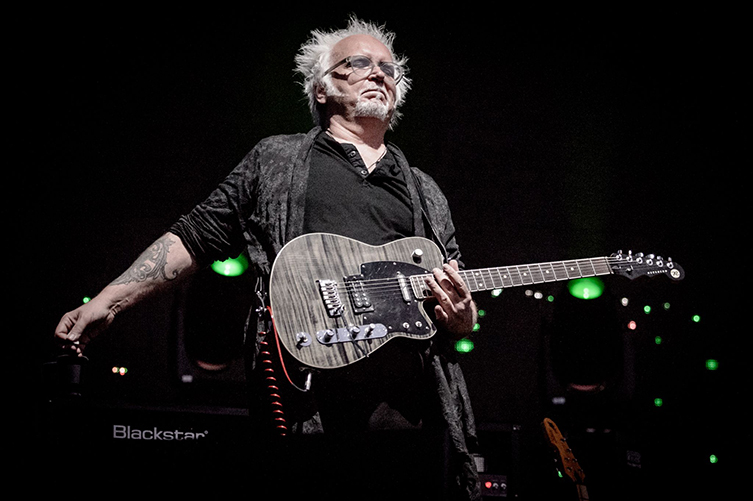
(Photo: Mauro Melis)
RG: So, we did the Signature model with the tremolo on it. Then I joined The Cure. Reverend has always been so supportive, and they actually took one of the Rick Vito models and modified it to what I wanted and started calling it the ‘Reevito’!
GG: Nice!
RG: They made me a 6-string bass, a one-off. Joe did that, because it wasn’t a production model. Then a Manta Ray with a Bigsby on it, because I knew I needed a Bigsby for a lot of the Cure stuff. And then after playing with The Cure for a while, I started thinking about what I needed, and what would be a really Cure-specific guitar. I talked to Joe a bit and started thinking: I always liked the way those Les Paul signature hollow bodies looked, the gold ones with the offset horns?
GG: Oh yeah, I know the ones.
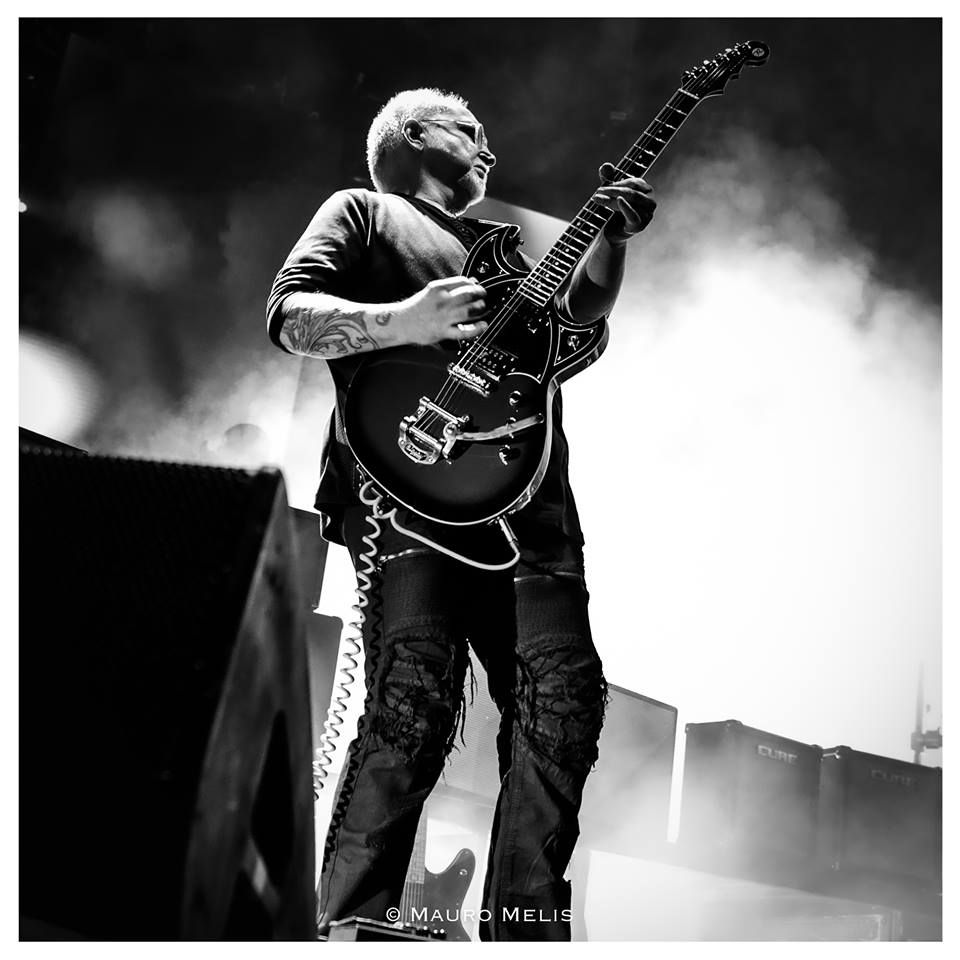
(Photo: Mauro Melis)
RG: I had a BB King Lucille that didn’t have f-holes, and that meant I could play way louder and not get feedback. I liked feeling the vibration of the hollow body, but I didn’t get that (makes feedback noise) thing that you can get. So, I talked to Joe and said, ‘What if we took the Sensei shape and just made it bigger.
GG: Cool.
RG: So that it looks like part of the Reverend family. He said he could contour the top like a Strat. On a semi-hollow, I’d never seen that. The other thing was, a friend of mine had a Les Paul Custom that had a Bigsby on it, but it had been played and used so much that he called it his ‘Hillbilly Floyd Rose’ (laughs) because it would move quite a distance because the spring was soft. When you didn’t touch it, it felt like you were playing something solid that wasn’t going anywhere.
"I go through periods where I don't want to use a tremolo. If I live in that space too much, I feel like a caricature."
Then I started doing a record in 2013. Bill Nelson and I had been in touch for years, and I am a huge Bill Nelson fan. We started working on a record together, and he had his original Sunburst finish ES-345, I think it was, with a Bigsby on it. His Bigsby was like that, too.
GG: Ah, right. A plan’s hatching.
RG: So, I started collecting springs (laughs). And then I did a horrible thing. I had a Custom Shop ES-335 and I put a Bigsby B5 on it. But then I started moving it, because I wanted a certain pitch from the strings behind the bridge. I found the location I wanted finally, so there are some extra screw holes in that guitar! The guy at a local place called Folkies did a really nice job of filling the holes in. It’s like when someone really takes the dents out of a car.
GG: Haha, yeah!
RG: Anyway, I tried a bunch of different springs and found one that was that weird combination of really soft and really long, so it would compress, but when I pulled it up it would expand, giving me a fourth on the G. Kinda almost Kahler/Floyd Rose territory, you know? You can’t get that on a Strat unless you back-route underneath the bridge. And I could drop it a fifth.
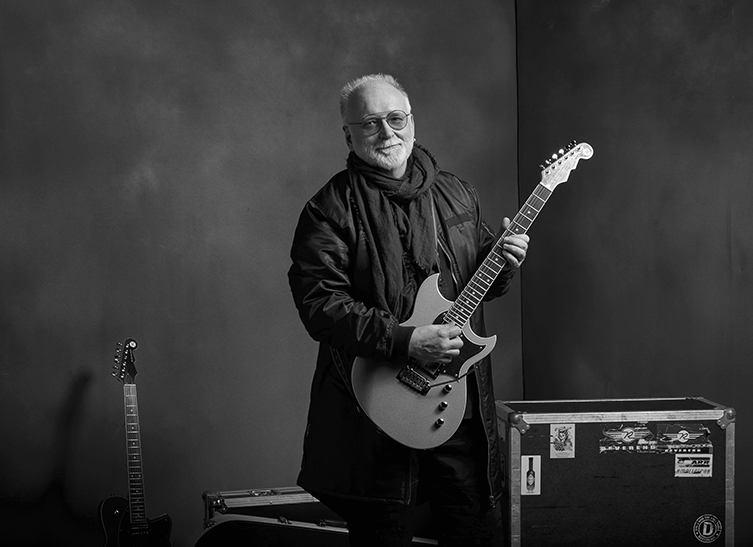
GG: Really?
RG: Yeah, which was way more than I needed in either direction for the Cure stuff. We put on a kill switch, and I was struggling with the pickguard, so Joe said, ‘Well, why don’t we segment the pickguard?’ Ultimately, I wanted a guitar for The Cure, and because The Cure is, looking at it from the US perspective, they’re the quintessential British band. Maybe 'British' isn’t the right word, but it’s a thing. The fact that I’m now in the thing is a mystery to me! (laughs)
I wanted the Spacehawk to look like if you wandered into a John Barry session for the Thunderball soundtrack, and Vick Flick was sitting there with this guitar, you wouldn’t think it was the wrong guitar for the era. Like, if you’d gone through a wormhole.
GG: Yeah, I see it!
RG: It’s super-playable. I can do all that sort of – for lack of a better reference point – Jeff Beck style fluttery stuff, I can pop the bar on the Bigsby and it’ll go (makes noise) like you can on a Floyd Rose...I can do all that with that guitar, but yet on the other hand, because of the way the bass contour circuit works, if I put the volume down to 8, those pickups seem to sound almost Gretsch-like. There’s a fair amount or firepower in the bridge pickup and the neck pickup’s sweet. Then I’ve got a push-pull on the tone control so I can flip them out of phase and get that Peter Green sound.
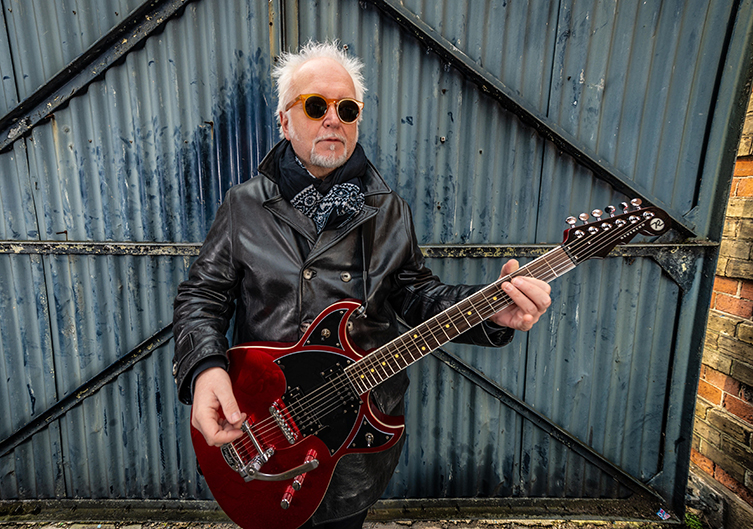
(Photo: Kan Lailey)
It’s the guitar I can do the entire show with, without changing it, if I had to. We have a pretty good touring mechanism, so we have guitar vaults and, y’know, I’m out with 14 guitars. I’ve got a Bass VI that Robert gave me to use, and I’ve got a couple of Spacehawks, I generally have a Les Paul with me now, and an RG-1 with the Sustainer. I’ve got one that got the nickname ‘tabby’ because it was that sort of black smoked top with the Maple underneath and it’s started to yellow a little bit around the striping, so it looks like a tabby cat (laughs). I put a kill switch on that and it has a Sustainer, so I use that when we do Wrong Number and one or two other songs. Any more, and it makes me misbehave! It works better, in the context of the band, if I have to fight the instrument more. It adds a little honest tension. Besides, no one needs to hear Allan Holdsworth on Never Enough.
GG: Yeah, totally! Haha!
RG: Then I’ve got a solid body nylon string acoustic and a solid body, Chet Atkins-style steel string, and an Italia electric sitar and a bunch of other things I’m probably forgetting.
GG: That’s quite a collection!
RG: Yeah! Oh, and one of the new centre-block Gretsches with a single cut and a Bigsby. Just because it looks cool.
GG: Exactly!
RG: I use in on A Forest and another song. Plus, Al Robinson, my guitar tech, he gets bored!
GG: Give him something to do!
RG: He gets annoyed with me if he doesn’t get his time on stage (laughs)
GG: Fair dos! Talking about that kind of thing, what’s your preference for string gauge?
RG: 9-46 generally. It started when I was playing the Steinbergers because the Transtrem didn’t work with 9-42. That’s back in, like, 1986. I use D’Addario NYXL and then 11-52 on the acoustics, and it’s all D’Addario stuff, except for the Bass VI, where I use the original Fender set. Yeah, nothing unusual. I’m always surprised when people make fun of lighter gauge strings. My argument is that heavy strings are for people who need something to hold on to!
GG: Haha, I like it! What about plectrums?
RG: Dunlop 1.14. I’ve been messing around with these Dunlop (Reeves rummages in his pick tin)...I think they were originally made for mandolin players or acoustic players, so I’ve mainly been using them on acoustic. Dunlop Prime Tone. I’m always buying other picks to try and I’m always dropping them and listening to what they sound like, which, you know...that’s a whole other thing. There’s apparently no cure for it!
GG: Haha, yes, I’m the same.
RG: I use the Tortex III, the ones that come with a point on them already. What I had to do, from 1980-something on, I’ve been taking regular shaped picks and making a point at the end for faster stuff. I hold my pick at an angle, and I make little circles when I pick, like I’m drawing little circles with a pen. What the point does is, when you’ve got a big rounded pick, the place where you can hit the string is bigger. The contact is bigger. When you angle it, and have a point, you’ve really only got one spot where you’re gonna hit it from. It doesn’t sound like a lot but when you’re playing 32nd notes at a fast tempo, if you wanna be metronomically accurate, it actually gets that to be a little more machine-like. I also use the Orange .60mm for Bass VI and acoustic. Anything where something’s gotta give, so as the strings get heavier, the picks get lighter for me.
Reeves Gabrels Solo Work
GG: Very briefly, we can just talk a little about your solo work? You mentioned already your collaboration with Bill Nelson, which is a real treat for guitar fans (the album is called Fantastic Guitars - Ray), and you’ve also had singers like David Bowie and Frank Black appear on your songs, and also the actor Gary Oldman! But my question is: is collaboration a large factor in your solo records? Does collaboration motivate you?
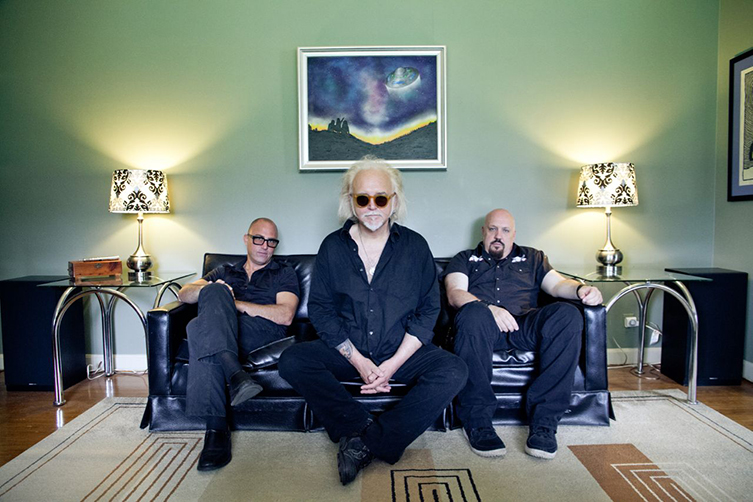
(Photo: Stacie Huckeba)
RG: Yeah, I think I’ve kind of come to accept the fact that I’m not a real starter (laughs). I’m kind of a reactive guy. If someone says, ‘I just found this: what the fuck is this?’, that would get me going. I’m not often the guy with the spark to do it. That’s changed more over the years, you know, I think I’m like 7 solo albums along, so I’ve kind of grown into being a self-starter (laughs). When you’re an improviser – if that’s the way you think of yourself – then by definition it’s reactive. You need stuff to play off of. One of the reasons why I like comedy is for that. Or, like, a good band is like a good conversation. A genius band is like a surreal version of a good conversation. So, I like the conversation.
"Gary Oldman's thing was that rock musicians get to take acting roles all the time, but no one ever has actors sing on rock songs. So I said: alright, here you go!"
GG: So, how did you manage to get Gary Oldman to do a vocal for you?
RG: I met Gary through David, but then I moved to England and gave him a call one day. He and I went down to Mustique, where David had a place, and we took David’s ocean-going yacht to Grenada. There’s a polaroid of Gary and I that David took on the yacht. Most of the writing we did in those days was on a Tascam Porta 1: I had one and David had one, so we just had to fly back and forth with our little box of cassette tapes. I was sketching out the song I Can’t Read on the 4-track and Gary’s sort of leaning in a chair. But, if you look, you can see through the window of this 100ft long, ocean-going yacht, and the ocean was at a 45-degree angle to how I was standing! You look down, you realise that my feet are off the ground! (laughs)
Anyway, Gary kept teasing me, like: ‘Let me sing on this!’ His thing was that rock musicians get to take acting roles all the time, but no one ever has actors sing on rock songs! Sol I called him up and said, ‘Alright: here you go!’ You know?
GG: Cool! Haha!
RG: I’d recorded You’ve Been Around for the first Tin Machine record and I was pushing for the first Tin Machine record to be a double record because we had another 8 songs that didn’t make it on there. The record company didn’t want a double record, so I took the song back. I did another version of it with David for the Black Tie White Noise record.
GG: Yeah.
RG: So, yeah, Gary just came in and ...sang.
GG: Good on him! Reeves, I’ve got so much here!
RG: Yeah, but there’s only about ten percent that’s useful!
Far from it. There was a little judicious editing from me, in order to make some sort of linear journey for you, the reader, but Reeves is one of the most quotable artists I’ve spoken to: I wasn’t too willing to leave any good material on the cutting room floor, as it were!
Afterwards, we both realised that we hadn’t gone into detail about his Reverend Dirtbike guitars or his custom Audio Kitchen amplifiers! Needless to say, if you are interested in checking these out, Reeves personally recommends them!
As we were signing off, I asked a little about some of my favourite Earthling guitar performances and sounds, and was amazed to hear that it was mostly just Reeves playing with his Sustainer and whammy bar with a couple of DI’d fuzz pedals. That wild noise at the beginning of Little Wonder? That’s Reeves playing a guitar. 3 notes. Those incredible shrieks during Seven Years in Tibet? A couple of tracks of Reeves dropping in with the same sustainer and whammy bar on his old hand-painted Parker Fly. The jaw drops. Where can we get hold of a Parker Fly?...
It was a shame to say goodbye, but we had already been on Facetime for quite some hours, and as my day in the UK was drawing to an end, so was Reeves' in upstate New York just beginning. It was a rare treat for a Bowie fan, a Cure fan and guitar fan, to have such uninhibited access to somebody who has lived and breathed such experiences. I hope that comes across, and I hope Reeves' warm-hearted sense of humour comes across, too.
Keep an eye out for forthcoming Cure news by heading over to the official Cure website. David Bowie’s 90s-era is currently being celebrated by a run of 6 limited edition live releases, where you’ll hear Reeves in full-on ‘loose cannon’ mode. Click through to the official David Bowie website so learn more.
As for Reverend guitars, we can help you out with that! We are proud dealers of this fantastic brand. Stock moves fast as these are popular instruments, but click through to view our current Reverend guitars, and keep an eye out for special limited edition finishes on all of Reeves’ signature instruments and other Reverend models as they appear.
We’d like to thank Reeves massively for being so generous with his time, and for sharing so much with us. We’d also like to thank Ken Haas for his help in setting us up.
As always, a heartfelt thanks goes out to you for reading and joining our adventure today! We sincerely appreciate you clicking through and reading. Thank you. There will be more!


